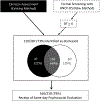Implementing a Tailored Psychosocial Distress Screening Protocol in a Head and Neck Cancer Program
- PMID: 34953151
- PMCID: PMC9875715
- DOI: 10.1002/lary.30000
Implementing a Tailored Psychosocial Distress Screening Protocol in a Head and Neck Cancer Program
Abstract
Objectives/hypothesis: Psychosocial distress is common among patients with head and neck cancer (HNC) and is associated with poorer quality of life and clinical outcomes. Despite these risks, distress screening is not widely implemented in HNC care. In this study, we investigated the prevalence of psychosocial distress and its related factors in routine care of patients with HNC.
Methods: Data from medical records between September 2017 and March 2020 were analyzed. Psychosocial distress was measured by the National Comprehensive Cancer Network's Distress Thermometer (DT), and a modified HNC-specific problem list; depression and anxiety were assessed using the Patient Health Questionnaire-4. Descriptive statistics and logistic regression were conducted to report prevalence of distress, depression and anxiety, and factors associated with clinical distress. Implementation outcomes, including rates of referrals and follow-up for distressed patients, are also reported.
Results: Two hundred and eighty seven HNC patients completed the questionnaire (age 64.3 ± 14.9 years), with a mean distress score of 4.51 ± 3.35. Of those, 57% (n = 163) reported clinical distress (DT ≥ 4). Pain (odds ratio [OR] = 3.31, 95% CI = 1.75-6.26), fatigue (OR = 2.43, 95% CI = 1.1.7-5.05), anxiety (OR = 1.63, 95% CI = 1.30-2.05), and depression (OR = 1.51, 95% CI = 1.04-2.18) were significantly associated with clinical distress (P < .05). Of patients identified as distressed, 79% received same-day psychosocial evaluation.
Conclusions: Clinical distress was identified in 57% of patients who completed the questionnaire, suggesting that an ultra-brief psychosocial screening protocol can be implemented in routine ambulatory oncology care, and identifies patients whose distress might otherwise go unrecognized.
Level of evidence: 4 Laryngoscope, 132:1600-1608, 2022.
Keywords: Distress screening; depression; head and neck cancer.
© 2021 The American Laryngological, Rhinological and Otological Society, Inc.
Figures


Comment in
-
Über die Hälfte der Kopf- und Halskrebspatienten ist psychosozial belastet.Laryngorhinootologie. 2022 Jun;101(6):456-457. doi: 10.1055/a-1772-3295. Epub 2022 Jun 1. Laryngorhinootologie. 2022. PMID: 35649399 German. No abstract available.
References
-
- National Comprehensive Cancer Network. NCCN Clinical Practice Guidelines in Oncology (NCCN Guidelines®) Distress Management (Version 1.2021). Accessed June 11, 2020. https://www.nccn.org/professionals/physician_gls/default.aspx#distress
-
- American College of Surgeons Commission on Cancer. Optimal Resources for Cancer Care 2020 Standards. Published 2019. Accessed June 11, 2020. https://www.facs.org/quality-programs/cancer/coc/standards/2020
-
- American Psychosocial Oncology Society. Clinical Guidelines. Accessed June 11, 2020. https://apos-society.org/professionals/clinical-guidelines/
MeSH terms
Grants and funding
LinkOut - more resources
Full Text Sources
Medical
Research Materials

